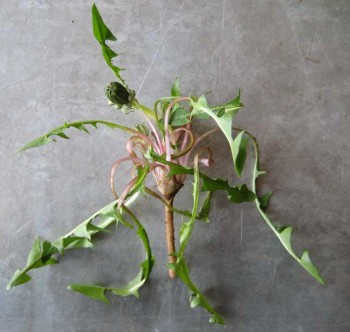
Yesterday another foot of snow fell at the house here at 11,000 feet in the Colorado Rockies. So much for the few hints of green that were beginning to poke out of the dirt. Fortunately, Gregg and I scored some small spring dandelions last weekend at his parents’ place at 6,100 feet in Aurora, on the outskirts of Denver.
Weeding Dandelions with Love
Gregg’s step-dad Jim was kind enough to let me weed dandelions from the part of the back yard where he doesn’t spray poison. We have a symbiotic relationship in that way—he needs edible weeds removed from his carefully tended landscape, and I want to eat them.
Have you ever weeded dandelions out of a lawn by hand? It’s not so bad if the soil is soft. Between the soft soil and the long metal hand weeding tool Jim supplied me, it was simply a matter of carefully extracting the dandelions—taproots, leaf stalks, leaves, buds, and all.
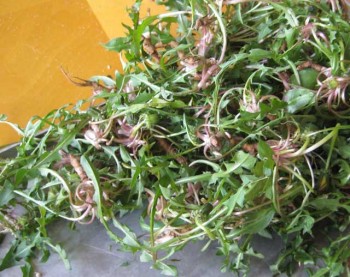
Here’s the technique I devised: First, I’d pull out a neat, hand-sized clump of grass and dandelions, then I’d thumb through that from the side for the pinkish-white bundles of new dandelion shoots attached to stringy, small leaves and long, thin brown taproots. These I pried carefully from the earth using a few well-aimed pokes with the weeder followed by careful wiggling and pulling. After all the dandelions were extracted from a given clump of grass, I stuck the grass back down and smushed it into place. Voila! In under an hour I had half a plastic grocery bag full of dandelion roots, leaf stalks, and leaves, and Jim had a relatively dandelion-free lawn. And, extracting them was a breeze compared to my less-than-successful attempt to dig up dandelion roots in the rocky soil of Fairplay last fall.
To wash the dandelions, I rinsed the whole tangled pile first and then each dandelion individually by prying open the new leaf stalks and rubbing the taproots as I sprayed them with the garden hose (which had a wonderful, adjustable power spray attachment). I don’t mind passing time this way—it definitely beat loading 15 tons of river rock into a wheelbarrow and distributing it around the house in the name of xeriscaping, which was the other project we were tasked with during our visit. It took more than an hour to wash my dandelion bounty, but that includes the occasional break to drink beer and soak up the sun.
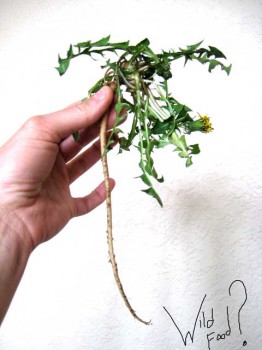
Eat Spring Dandelions Whole
I knew you could eat dandelion leaves, buds, flowers (although over-consuming flowers can upset Gregg’s stomach), crowns (where the leaves come in contact with the roots), and taproots. All of these plant parts are packed with nutrients; “Wildman” Steve Brill’s Identifying and Harvesting Edible and Medicinal Plants in Wild (and Not So Wild) Places (1994) has a good overview on the dandelion’s use to treat or prevent various ailments, including diabetes.
However, the one plant part I always removed prior to eating was the flower stalk, failing as I had to find reference to its edibility in any wild edible plants guide. And then I read Samuel Thayer’s account in Nature’s Garden (2010). “The dandelion’s flower and flower stalk are the parts that I eat most often,” he writes. “…For an interesting dish, you can cook the flower stalks into ‘dandelion noodles.’” Dandelion noodles? Cool.
(Incidentally there is a recipe for a very different kind of dandelion noodles in A Naturalist’s Guide to Cooking with Wild Plants, by Connie and Arnold Krockmal (1974)—that calls for making a dough of chopped dandelions, flour, eggs, and water, rolling it flat, cutting out the noodles, and then boiling like spaghetti.)
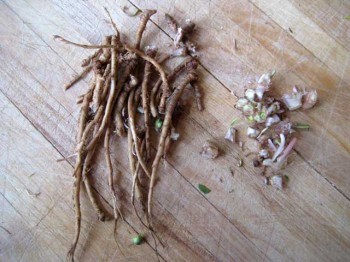
Anyway, as turns out—and this was a great epiphany for me—you can eat all parts of the dandelion. I would imagine this is especially true of young spring dandelions, which have yet to develop the strong bitter taste for which dandelions are known.
Don’t Knock the Small Dandelions
Thayer (2010) says, “Young dandelion roots make a decent vegetable; old roots are distinctly inferior. Small roots are not worth your time. So what you want are big, young dandelion plants…”
I giggled recollecting this as I set about cutting taproots from crowns and crowns from leaves—because the roots I’d gathered were skinny, not even the thickness of a pencil. “I think these are the ‘small roots’ that are not worth my time,” I told Gregg as I set a small pot of chopped roots, crowns, and leaves on the stove to boil. What can I say? I’ll take what I can get. I didn’t bother to scrub them, either, so they came out looking a little hairy from the thin rootlets coming off the main taproots.
I started by serving Gregg a small taste test of roots, crowns, leaf stalks, and young leaves in a ramekin with butter and salt. He liked the crowns best, but left some of the hairy roots on his plate. Because of this I decided to chop them into very small pieces for the actual dandelion side dish I was concocting to serve with dinner.
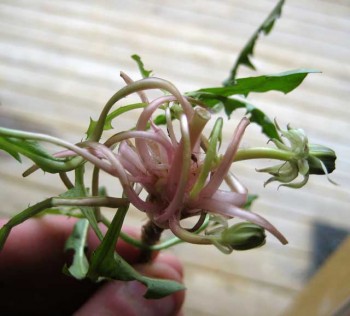
Tasty Tangle Surprise
As I processed my large, tangled pile of dandelions, I made an interesting discovery. Because I had painstakingly washed each one but left the roots intact, all of the dandelion leaf stalks (the pink/white part attached to the crown) grew a little during their two day stay in the refrigerator. These taste something like the crown; they are less bitter than the leaves and they have a pleasing crunch. So this turned out to be a boon—yummy, clean, curly new leaf stalks to add texture and flavor to my dish.
Whole Spring Dandelions Chopped and Boiled—Delicious!
Without further ado, then, here’s what I did for my dandelion side dish: First, I separated the roots from the crowns and the crowns from the leaf stalks/leaves. I chopped the roots into small pieces and boiled them with the crowns for slightly longer than the leaves, which I boiled in a separate pot (you could probably just do them all together). I boiled the plant parts for 10 to 15 minutes in total, drained, combined, and then served with butter and salt.
The different parts served together made for a great, variable texture that enhanced their mild, fresh taste—but Gregg stayed silent on the matter throughout dinner. It was not until we were cleaning the dishes that he spoke. “You know, I’m surprised those dandelions tasted so good,” he said. Success!
Updated 2.18.21

Impressed with your energy and efforts with the dandelions and purslane (enjoyed that article, too). Thinking of including more such foods in our diet, so was grateful for your shared info. and results. You write in a clear and enjoyable style. Thank you again.
Thanks to you, Sandra. I appreciate the kind words and encouragement!
WFG/Erica –
My almost 10 y/o and I have just started our journey with dandelion ‘coffee’ this week. We love it! 2 rounded tsp roasted dandelion root (I roasted the raw root purchased from the bulk aisle at Vitamin cottage), 2 tsp. roasted chickory root (purchased as such at V.Cott.) to 2 C’s H20. You are supposed to boil it for 5 – 10 minutes but I’m only able to infuse it – LOVELY. It is great with a cinnamon stick. Or, with a splash of vanilla. Or, with a bag or two of Roastaroma Tea by Celestial Seasonings (YUM). And quite delicious with a small addition of good quality of cocoa. I’m going to try it with some (home)dried orange peel. Soon I want to purchase some raw(to roast) Carob to add.
Hope that helps!
by HIS grace alone,
HveHope
This is where we got our basic recipe:
http://www.elanaspantry.com/dandelion-root-coffee/
which we were pointed to from one of my all-time favorite writers:
http://www.studyinbrown.com/who-am-i/
thanks!
by HIS grace alone,
HveHope
Thanks, HveHope. Spring is just around the corner so I’ll give it another go:)